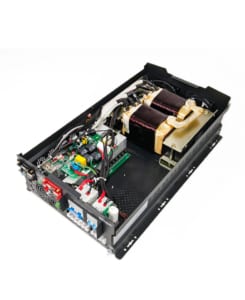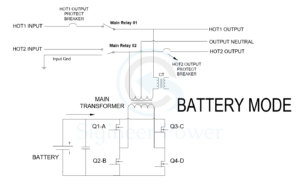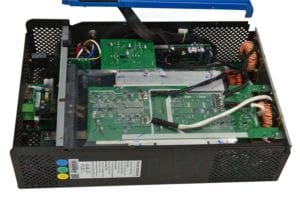High frequency vs low frequency pure sine wave inverter & difference explanation
High frequency vs low frequency pure sine wave inverter & difference explanation
There are two types of power inverters on the market: low frequency inverter and high frequency inverter.
No matter the inverter is high or low frequency, there are pros and cons for each design.
By definition, Low frequency power inverters got the name of “low frequency” because they use high speed power transistors to invert the DC voltage to AC power, but the LF inverter drives transistors at the same power frequency (60 Hz or 50Hz) as the AC sine wave power output voltage.
High frequency power inverters typically convert the DC to AC by driving the transistors at a much higher frequency from 50 Kilo Hz to a few million Hz.

Low Frequency Inverter design with heavy-duty transformer

Low frequency inverter circuit diagram

High Frequency Inverter without large builtin transformer
When delivering the same amount of power supply, the low frequency transformer outputs more power at each cycle, so it is required to work harder, resulting in a larger and heavier weight and package.
The high frequency inverter can deliver the same power at higher frequency with a much smaller and lighter transformer, as a result, the HF inverter is often called transformer-less inverter, or TL inverter.
With its smaller transformer, high frequency inverters typically surge at a lower rate, and/or for shorter periods of time than its low frequency counterparts.
With the new technologies implemented on power inverters, a low frequency inverter can now match or even outpace high frequency in idle consumption and max THD.
Both of the two type of inverters can be built with utility charger or solar charger and be called “inverter charger”.
Here is the major difference of them:
Thanks to the heavy-duty transformer, low frequency inverters have much higher peak power capacity and reliability.
The transformer handles higher power spikes with longer duration than high-frequency inverters when it comes to driving inductive loads such as electric motor, pump, compressor, air conditioners.
The Sigineer low-frequency inverters can output a peak 300% surge power for 20 seconds, while high-frequency inverters can deliver 200% surge power for 5 seconds, check our HF solar power inverters.
Low-frequency inverters take power impact through its big transformer which acts like a surge relief for the circuit.
While for high-frequency inverter, their electronic parts such as the MOSFETs are directly subject to load power fluctuations.
With fewer PCBs, low-frequency inverters are easier and cheaper to repair.

Leave a Reply
Want to join the discussion?Feel free to contribute!